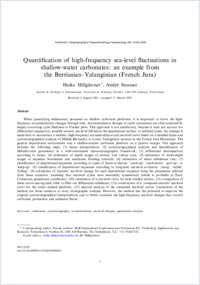Quantification of high-frequency sea-level fluctuations in shallow-water carbonates: an example from the Berriasian–Valanginian (French Jura)
Université de Fribourg
- Hillgärtner, Heiko Department of Geosciences, University of Fribourg, Switzerland
- Strasser, André Department of Geosciences, University of Fribourg, Switzerland
-
18.12.2003
Published in:
- Palaeogeography, Palaeoclimatology, Palaeoecology. - 2003, vol. 200, no. 1-4, p. 43-63
English
When quantifying sedimentary processes on shallow carbonate platforms, it is important to know the high-frequency accommodation changes through time. Accommodation changes in cyclic successions are often analysed by simply converting cycle thickness to Fischer plots. This approach is not satisfactory, because it does not account for differential compaction, possible erosion, sea-level fall below the depositional surface, or subtidal cycles. An attempt is made here to reconstruct a realistic, high-frequency accommodation and sea-level curve based on a detailed facies and cyclostratigraphical analysis of Middle Berriasian to Lower Valanginian sections in the French Jura Mountains. The general depositional environment was a shallow-marine carbonate platform on a passive margin. Our approach includes the following steps: (1) facies interpretation; (2) cyclostratigraphical analysis and identification of Milankovitch parameters in a well-constrained chronostratigraphic framework; (3) differential decompaction according to facies; (4) estimation of depth ranges of erosion and vadose zone; (5) estimation of water-depth ranges at sequence boundaries and maximum flooding intervals; (6) estimation of mean subsidence rate; (7) classification of depositional sequences according to types of facies evolution: ‘catch-up’, ‘catch-down’, ‘give-up’, or ‘keep-up’; (8) classification of depositional sequences according to long-term sea-level evolution: ‘rising’, ‘stable’, ‘falling’; (9) calculation of ‘eustatic’ sea-level change for each depositional sequence using the parameters inferred from these scenarios, assuming that sea-level cycles were essentially symmetrical (which is probable in Early Cretaceous greenhouse conditions); (10) calculation of a sea-level curve for each studied section; (11) comparison of these curves among each other to filter out differential subsidence; (12) construction of a ‘composite eustatic’ sea-level curve for the entire studied platform; (13) spectral analysis of the calculated sea-level curves. Limitations of the method are those common to every stratigraphic analysis. However, the method has the potential to improve the original cyclostratigraphical interpretations and to better constrain the high-frequency sea-level changes that control carbonate production and sediment fluxes.
- Faculty
- Faculté des sciences et de médecine
- Department
- Département de Géosciences
- Language
-
- English
- Classification
- Geology
- License
- License undefined
- Identifiers
-
- RERO DOC 5008
- DOI 10.1016/S0031-0182(03)00444-9
- Persistent URL
- https://folia.unifr.ch/global/documents/299536
Statistics
Document views: 104
File downloads:
- 1_strasser_qhf.pdf: 71
